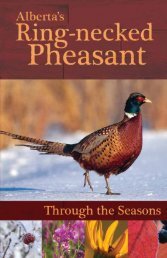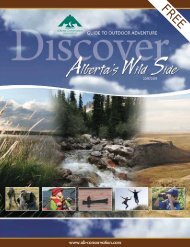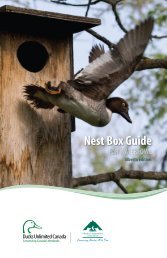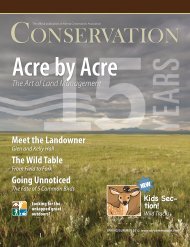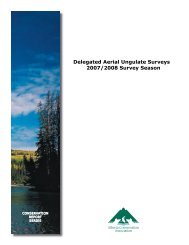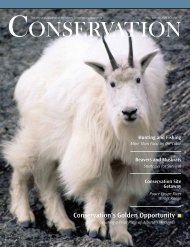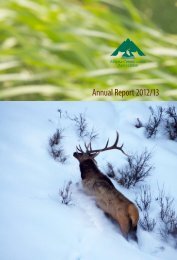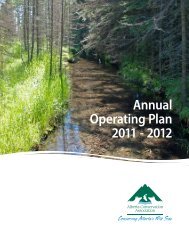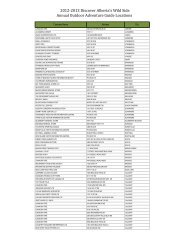Water-loving Weasels - Alberta Conservation Association
Water-loving Weasels - Alberta Conservation Association
Water-loving Weasels - Alberta Conservation Association
You also want an ePaper? Increase the reach of your titles
YUMPU automatically turns print PDFs into web optimized ePapers that Google loves.
Maria Didkowsky<br />
“From our data we detected that most of the<br />
collared does spent, on average, four days<br />
moving parallel to Highway 1 before they were<br />
able to successfully cross the highway. One doe<br />
spent 10 days trying to cross the Trans-Canada<br />
Highway. The bottlenecks are becoming tighter<br />
and tighter,” says Suitor, “which could result in<br />
serious consequences for the distribution of<br />
pronghorn in the more northern portion of the<br />
province.”<br />
Fences are another difficulty pronghorn face, as<br />
most roads are fenced on both sides. Pronghorn<br />
prefer to crawl under fences to cross a highway,<br />
rather than jumping, as is the case with deer<br />
and elk. Suitor says if the bottom wire is too low<br />
to the ground the fence acts as a barrier and<br />
impedes pronghorn movement.<br />
“Our results also showed that barbed wired<br />
fences remove hair and cause scarring of the<br />
tissue along the back. We all agreed that to assist<br />
with pronghorn movement, we need to examine<br />
fencing practices in <strong>Alberta</strong>. The bottom wire not<br />
only needs to be braided, smooth and barbless,<br />
it needs to be raised to a minimum height of 18<br />
inches off the ground.<br />
Northern Sagebrush Steppe Initiative<br />
Thanks to these research studies, Grue says<br />
they understand that pronghorn management<br />
in <strong>Alberta</strong> expands beyond the border and is<br />
impacted by management in both Saskatchewan<br />
and Montana.<br />
He gives an example of a pronghorn doe,<br />
collared near Wild Horse, <strong>Alberta</strong> during the<br />
winter of 2003-2004. After spending the winter<br />
in the southeastern corner of <strong>Alberta</strong>, when<br />
spring arrived, she seemed to disappear into<br />
thin air. “We assumed that her collar had failed,<br />
and she was likely still in the area but not<br />
detectable,” says Grue. “However, last fall, a<br />
Montana landowner called us to let us know she<br />
had found the doe’s collar in one of her fields.”<br />
The collar provided valuable information.<br />
During those spring months, the doe had moved<br />
southeast into Montana and had stayed there<br />
until her collar dropped off. “She was a unique<br />
animal in that she moved south in the spring of<br />
2004 when the rest of our migratory pronghorn<br />
moved north,” explains Grue. “But the key to the<br />
movement was that it showed us how connected<br />
our population is to Montana.”<br />
To help with the information exchange, a<br />
Memorandum of Understanding (MOU) was put<br />
in place between <strong>Alberta</strong>, Saskatchewan and<br />
Montana management agencies under the name<br />
of the Northern Sagebrush Steppe Initiative.<br />
Thanks to the efforts of University of Calgary<br />
professor Dr. Cormack Gates, and <strong>Alberta</strong> Fish<br />
and Wildlife Division biologist Dale Eslinger, both<br />
collaborators with the <strong>Alberta</strong> work, state that<br />
the MOU fosters collaborative initiatives and<br />
information exchange between the jurisdictions,<br />
even though the Initiative is not solely focused<br />
on pronghorn.<br />
The expansion of the pronghorn work in <strong>Alberta</strong><br />
is one such initiative. Similar work is being<br />
conducted in the two other jurisdictions. Twenty<br />
pronghorn does, located in northern Montana,<br />
were fitted with GPS collars in the winter of<br />
2008, thanks to assistance from the World<br />
Wildlife Fund in the U.S, Montana Fish, Wildlife<br />
& Parks and Saskatchewan Environment. An<br />
additional 40 does were fitted with GPS collars<br />
in Montana and nine collars were deployed in<br />
southern Saskatchewan this past winter. Andrew<br />
Jakes with the University of Calgary is working<br />
on the study with support from Petro-Canada<br />
Sustainable Grassland Program. Mass migrations<br />
occurred because of the severe winter conditions<br />
experienced in December 2008 and January<br />
2009. Several hundred pronghorn were even<br />
tracked moving south past the Milk River in<br />
Montana, to the banks of the Missouri River.<br />
Grue says that collaborations such as the<br />
Northern Sagebrush Steppe and investigations<br />
into the ecology and movement will be the key<br />
to pronghorn management and conservation<br />
in <strong>Alberta</strong>. “Turning our results into positive,<br />
on-the-ground benefits for pronghorn, will be<br />
one of the key objectives in the future of the<br />
program.” n<br />
8<br />
<strong>Conservation</strong> Magazine • Spring/summer 2009





